In a Process model, Message Flow objects represent messaging between objects of (or within) one Pool object to objects of (or within) another Pool object. Message Flow objects cannot connect to Process model objects within the same Pool object. Message Flow objects are not to be confused with Sequence Flow objects.
Use Message Flow objects to represent collaboration and transfer of Request data from one Pool to another. Since each Pool object in a Process uses its own Request and Request data, use Message Flow objects to exchange data and information between separate Pool objects and/or objects within those Pool objects.
These messages indicate the transfer of Request data between separate Process model objects. Use a Text Annotation object to add descriptive information about the nature of the data transfer.
Flow indicators display when you click an object in the Process model.
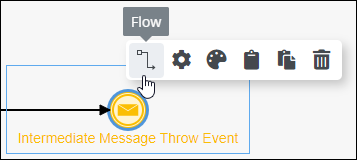
Incoming and Outgoing Message Flow
From the context of a Process model object associated with a Message Flow object, that Message Flow object can be "incoming" or "outgoing." Consider the following Process model example to demonstrate their differences.

Message Flow object is outgoing for Task 1, but incoming for Task 2
Below are the differences between incoming and outgoing Message Flow objects:
Incoming: An incoming Message Flow object comes from its connecting object. In the Process model example above, the Message Flow object is incoming to the "Task 2" object.
Outgoing: An outgoing Message Flow object goes to the connecting object. In the Process model example above, the Message Flow object is outgoing from the "Task 1" object. The outgoing Message Flow object must originate from a separate Pool object than from where it connects.
Restrictions on Message Flow Objects
Message Flow objects are not used in two general categories of Process model objects:
BPMN 2.0 Specification Objects That Do Not use Outgoing Message Flow Objects
The following objects from the BPMN 2.0 specification do not use outgoing Message Flow objects:
Events
Start Event object
Start Timer Event object
Signal Start Event object
Message Start Event object
Conditional Start Event object
Intermediate Timer Event object
End Event object
Message End Event object
Error End Event object
Signal End Event object
Terminate End Event object
Boundary Timer Event object
Boundary Error Event object
Boundary Signal Event object
Boundary Message Event object
Tasks
Form Task object
Manual Task object
Script Task object
Sub Process object
Gateways
Exclusive Gateway object
Inclusive Gateway object
Parallel Gateway object
Event-Based Gateway object
Annotations and Associations
Text Annotation object
Association object
Data Object object
Data Store object
Data Association Flow object
Flow Indicators
Sequence Flow object
Non-BPMN 2.0 Specification Process Model Objects
Furthermore, all Process model objects not part of the BPMN 2.0 specification do not use Message Flow objects. This includes the following:
Connect the Message Flow Object Between Objects in Separate Pool Objects
Connect two Process model objects with a Message Flow object to message between objects of (or within) one Pool object to objects of (or within) another Pool object. Message Flow objects cannot connect to Process model objects within the same Pool object. Ensure that the two objects to connect use Message Flow objects as described in the Overview.
Permissions
Your user account or group membership must have the following permissions to configure Message Flow objects in the Process model unless your user account has the Make this user a Super Admin setting selected:
Processes: Edit Processes
Processes: View Processes
See the Process permissions or ask your Administrator for assistance.
Follow these steps to set the Message Flow object between objects in separate Pool objects:
Ensure that the Process model has at least two (2) Pool objects from which to establish Message Flow between them.
From one Pool object, select the Process model object to which to establish messaging via the Message Flow object. Available options display to the right of the selected object. Process model object types that do not support the Message Flow object do not have the Message Flow indicator as highlighted below.
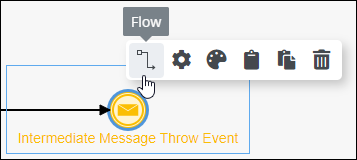
Click the Flow icon
 .
.Do one of the following:
Click the second Pool object to indicate messaging between the two objects.
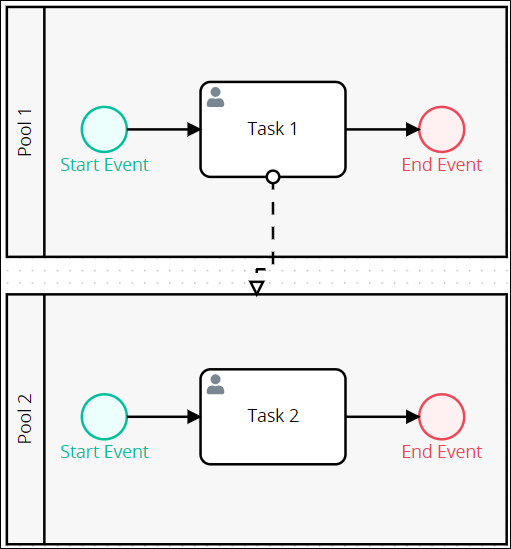
Click an object inside the second Pool object to indicate messaging between the two objects.
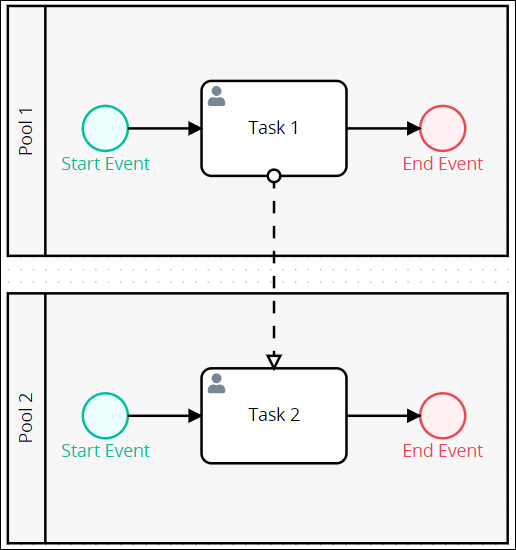
Reconnect a Message Flow Object from One Process Model Object to Another That Are in Separate Pool Objects
Optionally, reconnect a Message Flow object from one Process model object to another that are in separate Pool objects. In doing so, select to which Process model object messaging routes for that Message Flow object. A Message Flow object cannot be reconnected from the outgoing Process model object. Ensure that the two objects to connect use Message Flow objects as described in the Overview.
Follow these steps to reconnect a Message Flow object from one Process model object to another that are in separate Pool objects:
Select the Message Flow object to reconnect to another Process model object.
Click the Message Flow object's arrow.
Click the other Process model object to which to set the message routing. The target Process model must be in a separate Pool object or a separate Pool object. The target Process model object may already have at least one other Message Flow object incoming to it.
Adjust How a Message Flow Object Bends Using Anchors
Use anchors in a Message Flow object to adjust how that Message Flow object bends between its connecting objects.
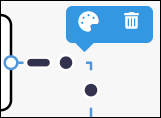
Follow these steps to adjust where a Sequence Flow object bends:
Connect a Message Flow object from one object to another.
Select the Message Flow object so that available options display above the selected object. Message Flow objects that have immediately been connected require two clicks of the Message Flow object for anchors to display.
Do one of the following:
Drag an existing round anchor
 to place where to bend that Message Flow object.
to place where to bend that Message Flow object.Click, and then drag, on a straight line of the Message Flow object to add a round anchor, then place where to add a bend in that Message Flow object.
Click an existing round anchor to delete it, thereby removing that bend in that Message Flow object.
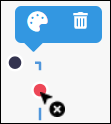
Settings
The Message Flow object has the following panels that contain settings:
Configuration panel
Documentation panel
Advanced panel
Configuration Panel Settings
Edit the Object Name
An object name is a human-readable reference for a Process object.
Follow these steps to enter or edit the name for a Message Flow object:
Select the Message Flow object from the Process model in which to edit its name.
Ensure that the Configuration panel displays. If not, show it. The Name setting displays. This is a required setting.
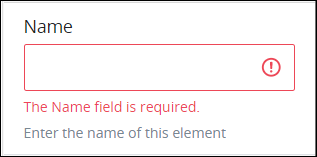
In the Name setting, enter or edit the selected object's name and then press Enter.
Documentation Panel Settings
Describe the object's purpose and how it functions in the Process. This description does not affect Requests for the Process, but may be useful for Process model maintenance such as how the object is configured. Edit information by using the What-You-See-Is-What-You-Get (WYSIWYG) rich text editor.
A Process's entered documentation displays by selecting the View Documentation icon for that Process.
Edit the Object's Description Displayed in Process Documentation
Follow these steps to edit the description for an object:
Select the object from the Process model in which to edit its description.
Ensure that the Configuration panel displays. If not, show it. Panels to configure this object display.
Expand the Documentation panel if it is not presently expanded. The Description setting displays.
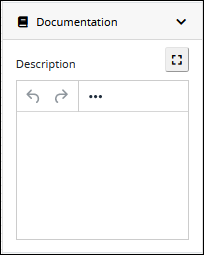
In the Description setting, edit the information to display when viewing documentation for this object and then press Enter. Alternatively, use the What-You-See-Is-What-You-Get (WYSIWYG) rich text editor to stylize your text by clicking the More icon
 .
.
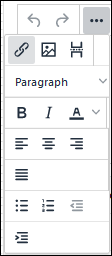
Follow these guidelines to use the WYSIWYG rich text editor to stylize your text:
Undo changes: Click on the
 icon to undo the last action.
icon to undo the last action.Redo changes: Click on the
 icon to redo the last undone action.
icon to redo the last undone action.Insert/Edit Link: Click on the
 icon to convert the selected text into a hyperlink. Follow these steps to create a hyperlink:
icon to convert the selected text into a hyperlink. Follow these steps to create a hyperlink: Select the required text from the Rich Text control.
Click on the
 icon. The Insert/Edit Link screen displays.
icon. The Insert/Edit Link screen displays.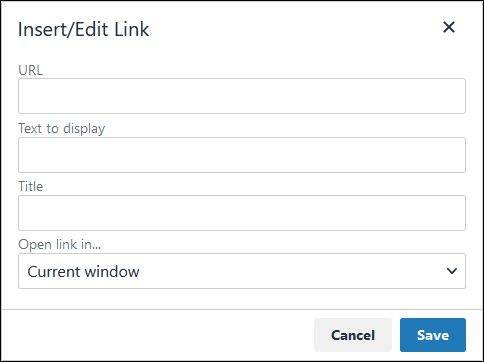
In the URL setting, enter the destination URL.
In the Text to display setting, edit or enter the text displayed in the Rich Text control.
In the Title setting, enter the text to display when a user hovers over the displayed text.
From Open link in… drop-down menu, select one of these options:
New window: Select this option to open the destination page in a new browser window.
Current window: Select this option to open the destination page in the current browser window.
Insert/Edit Image: Click on the Insert/Edit Image icon
 to insert an image. Follow these guidelines:
to insert an image. Follow these guidelines: Click on the Insert/Edit Image icon
 .
. The Insert/Edit Image screen displays:
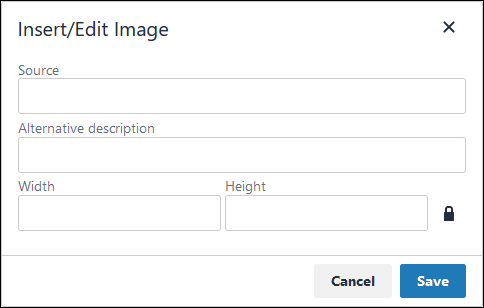
In the Source setting, enter a URL for the image.
In the Alternative Description setting, enter the text to display if the source URL of the image is not accessible.
In the Width setting, enter the maximum width for the image.
In the Height setting, enter the maximum height for the image.
Toggle the Constrain Proportions icon
 to maintain the width-height ratio of the image to its original proportion.
to maintain the width-height ratio of the image to its original proportion. Click Save.
Insert Page Break for PDF: Click on the Insert Page Break for PDF icon
 to insert a page break when a PDF document is created for this documentation if your browser supports this feature.
to insert a page break when a PDF document is created for this documentation if your browser supports this feature. Format text: Follow these guidelines to format text:
Headings: From the Paragraph/Formats menu, select Headings and then select a heading size.
Bold: Do one of the following:
From the editor toolbar, select the
 icon.
icon.From the Paragraph/Formats menu, select Inline and then Bold.
Italics: Do one of the following:
From the editor toolbar, select the
 icon.
icon.From the Paragraph/Formats menu, select Inline and then Italic.
Underline: From the Paragraph/Formats menu, select Inline and then Underline.
Strikethrough: From the Paragraph/Formats menu, select Inline and then Strikethrough.
Superscript: From the Paragraph/ Formats menu, select Inline and then Superscript.
Subscript: From the Paragraph/Formats menu, select Inline and then Subscript.
Code: From the Paragraph/Formats menu, select Inline and then Code.
Paragraph: From the Paragraph/Formats menu, select Blocks and then Paragraph.
Blockquote: From the Paragraph/Formats menu, select Blocks and then Blockquote.
Division: From the Paragraph/Formats menu, select Blocks and then Div.
Preformatted: From the Paragraph/Formats menu, select Blocks and then Pre.
Change text color: Use the Text Color drop-down to change text color. Click on the
 icon. The color palette displays. Do one of the following:
icon. The color palette displays. Do one of the following:Select one of the color swatches from the color palette. The selected text changes to that color.
Click the
 icon to select a custom color from the Color Picker.
icon to select a custom color from the Color Picker.Click the
 icon to reset the text to its default color.
icon to reset the text to its default color.
Align text: Follow these guidelines to align text:
Left align: Do one of the following:
From the editor toolbar, use the
 icon to left-align text.
icon to left-align text.From the Paragraph/Formats menu, select Align and then Left.
Center align: Do one of the following:
From the editor toolbar, use the
 icon to center-align text.
icon to center-align text.From the Paragraph/Formats menu, select Align and then Center.
Right align: Do one of the following:
From the editor toolbar, use the
 icon to right-align text.
icon to right-align text.From the Paragraph/Formats menu, select Align and then Right.
Justify: Do one of the following:
From the editor toolbar, use the
 icon to justify text.
icon to justify text. From the Paragraph/Formats menu, select Align and then Justify.
Insert a bullet list: Use the
 icon to format text as a bulleted list.
icon to format text as a bulleted list.Insert a numbered list: Use the
 icon to format text as a numbered list.
icon to format text as a numbered list.Indent text: Click on the
 icon to increase text indenting.
icon to increase text indenting.Outdent text: Click on the
 icon to decrease text indenting.
icon to decrease text indenting.
Advanced Panel Settings
Edit the Node's Identifier Value
Process Modeler automatically assigns a unique value to each Process node added to a Process model. However, a node's identifier value can be changed if it is unique to all other nodes in the Process model, including the Process model's identifier value.
All identifier values for all nodes in the Process model must be unique.
Follow these steps to edit the identifier value for a Message Flow object:
Select the Message Flow object from the Process model in which to edit its name.
Ensure that the Configuration panel displays. If not, show it. Panels to configure this object display.
Expand the Advanced panel if it is not presently expanded. The Node Identifier setting displays.
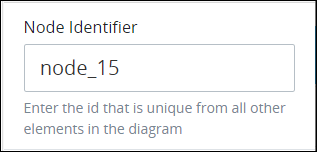
In the Node Identifier setting, edit the Message Flow object's identifier to a unique value from all nodes in the Process model and then press Enter.